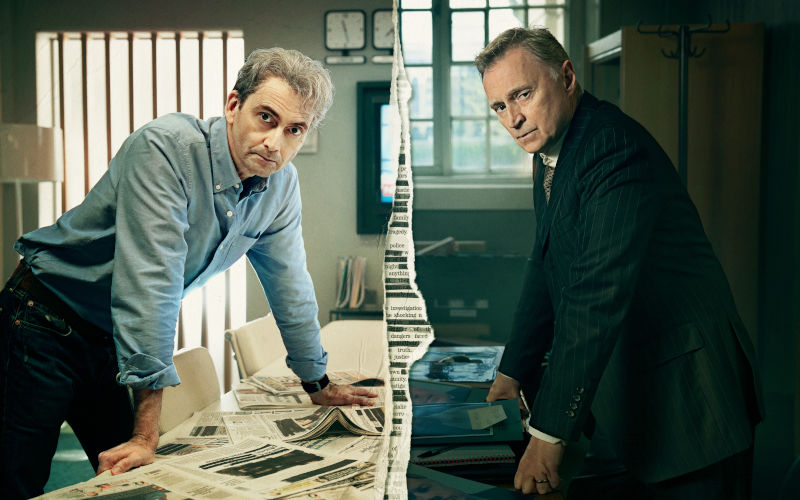Journos as heroes and villains - 'The Hack' reviewed - Part 1
October 9, 2025
In films and on the small screen, journalists are portrayed as heroes or villains. In The Hack they are both. Does this reflect the diminished, benighted standing journalists hold in society today or is it a step forward in showing the complexities of the work?
It may be both. The seven-part series recently released on the streaming service, Stan, is about the phone hacking scandal in the United Kingdom. It has a stellar cast, (David Tennant and Toby Jones) and was written by Jack Thorne, who recently won an Emmy for his work on Adolescence.
Before looking at The Hack, it is useful to set it in the context of how journalists and journalism are portrayed in film and on television. A lot is the first point to make about it, as the 100,000 items in the Image of the Journalist in Popular Culture database attest.
Early on, journalists were portrayed as lovable rogues in films like The Front Page (1931) and His Girl Friday (1940) but the journalist as hero or villain becomes prominent soon after. In 1952, Humphrey Bogart played a newspaper editor determined to expose a gangster’s crimes in Deadline USA, while in Ace in the Hole (1951) Kirk Douglas plays a reporter who ensures the rescue of a man trapped in a cave is prolonged for the sake of his story.
The characters in those films were fictional but it was a true story that defined the image of the journalist as hero. All the President’s Men (1976) focused on the work of two young reporters, Carl Bernstein and Bob Woodward, in exposing how the White House of president Richard Nixon covered up the scandal surrounding the break-in at the Democrat Party’s headquarters in the Watergate hotel-office complex.
The late Robert Redford, then at the peak of his fame, played Woodward. Redford made no effort to mimic Woodward’s deliberate speaking manner. As Jordan Orlando writes: “His performance is a star turn – simply by standing on screen, Redford imbues Woodward, the Post, and all of journalism with Hollywood glitter."
It was Paul Newman, the then perhaps even more famous star who had partnered with Redford in Butch Cassidy and the Sundance Kid and The Sting, who played a leading role in Absence of Malice as the victim of the harm journalism could do.
The film appeared only five years after All the President’s Men and is little remembered today despite Newman receiving an Oscar nomination for it, but Absence of Malice powerfully dramatised how a set of facts can be accurately reported but still be far from the truth.
Just why the film is not famous may be simply because it wasn’t all that memorable or that audiences struggled to accept the idea of Sally Field, then best known as The Flying Nun, playing a morally compromised journalist. Or it may have something to do with the film exploring some of the ethical murkiness inherent in journalism.
There is an additional reason, though, which will bring us to the Murdoch media empire and the phone hacking scandal. Newman was a Hollywood icon, but for much of his career his name was mentioned negatively or not at all in the Murdoch-owned New York Post. In its TV guide, if a Newman film like Hud was scheduled, it would be listed as “Hud, starring Patricia Neal” according to Shawn Levy’s 2009 biography of the actor.
The campaign against Newman began as a dispute about his height, with the newspaper, in what appeared to be a calculated barb, writing he was shorter than he was, but the real issue was Newman’s liberal politics, and then his advocacy for a film that questioned the heroic self-image of journalism, especially at tabloid newspapers like the Post. For his part, Newman didn’t take any of the newspaper’s regular potshots lying down. He once said he would sue The Post for defamation but “it’s awfully hard to sue a garbage can”.
Undoubtedly, the actions of journalists can be villainous or heroic. On the latter, you only need to recall the 2015 film Spotlight which showed the exemplary real-life work of The Boston Globe’s investigative team in revealing how Catholic priests sexually abused children.
Even the most fervent supporter of investigative journalism would admit that the Spotlight team’s disclosures are rare among the vast mass of journalism produced, which on any given day ranges from very good to average to inconsequential before reaching the kind of media atrocities dissected weekly by ABC TV’s Media Watch.
Similarly, in recent decades, the depiction of journalism ranges from Shattered Glass (2003), about an American magazine journalist who fabricates his stories, to Nightcrawler (2014) which delves into the murky world of a (literal) ambulance-chasing local news stringer, played by Jake Gyllenhaal. The Australian television series Frontline satirised tabloid current affairs programs over three seasons, while in Anchorman (2004), Will Ferrell pricked the pomposity, not to mention the sexism, of 1970s local television news.
Films and TV series that explore the complexities of journalism are rarer, which is why The Hack is welcome, as we will see.
The views expressed in this article may or may not reflect those of Pearls and Irritations.
